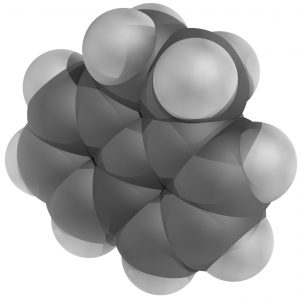Acenaphthene
Acenaphthene Definition
Acenaphthene is a polycyclic aromatic hydrocarbon with an ethylene bridge linking 1 and 8 site.
Acenaphthene Names
This hydrocarbon is also known by other names like
- Acenaphthylene
- 1,2-Dihydroacenaphthylene
- 1,8-Ethylenenaphthalene
- Peri-Ethylenenaphthalene
- Aphthyleneethylene
Acenaphthene Molecular Weight
Its molecular formula is C12H10.
Acenaphthene Solubility
The solubility of this substance in water is 0.4 mg/100 ml.
Acenaphthene Boiling Point
The boiling point for Acenaphthene is 279 °C (552 K, 534 °F).
Acenaphthene Chemical Facts
Some key chemical statistics on Acenaphthene are:
- Density: 1.222
- Melting Point: 93.4 °C (367 K, 200 °F)
- Vapor Pressure: 0.3 (Pa at 25°C)
- Relative Vapor Density: 5.3 (air=1).
- Flash Point: 135°C o.c.
- Auto-Ignition Temperature: > 450 °C
- Half Life: Biodegradation in Aerobic Soil Varies from less than 10 to 102 days
Picture 1 – Acenaphthene
Source – en.wikipedia.org
Other Facts and Identification Features
Some of the other important facts and identification features of this substance are:
- It appears as white beige in color.
- This substance exists as a pure ingredient as well as constituent of polyaromatic hydrocarbon (PAH) mixture.
- It is a component of coal tar.
- Its alternative name 1, 2-Dihydroacenaphthylene underlines that it is a hydrogenated form of Acenaphthylene.
- It does not have fluorescence, which is quite contrary to most polycyclic aromatic hydrocarbons.
Material Safety Data Sheet (MSDS)
It is a combustible substance. Its powdered particles can lead to dust explosions with air. There is a risk that on combustion, it could lead to formation of contaminated gases like Carbon Monoxide. This substance reacts with strong oxidants.
Source of Human Exposure
Human beings are exposed to it by inhalation of its aerosol, skin contact or by ingestion. Its odor detection in air is 8.0X10-2 ppm (chemically pure). Threshold odor concentration in water at room temperature is 0.08 ppm (range 0.02 to 0.22 ppm) with odor low of 0.5048 mg/cu m, and odor high 0.5048 mg/cu m.
This substance has been found in drinking water. It is reported that two of five samples of Nordic tap water in US included Acenaphthene at a concentration of 7.4 – 14.0 ng/l. In an investigation of drinking water supplies in the UK, Acenaphthene was detected at 2 of 14 water facilities.
Health Implications on Exposure
On inhalation, a damaging absorption of airborne particles can be attained rapidly when scattered. Studies have shown exposure to this substance can lead to cancer and adverse effects on the cardiovascular system.
First Aid
In case of inhalation, shift to a place with abundant fresh air and take rest. If your skin has been exposed to this chemical, remove polluted clothes and wash skin thoroughly. For eyes, first rinse with plenty of fresh water (after removing lens) before consulting a doctor. In case of ingestion, rinse mouth thoroughly.
Precautions for Operators
Those working with it are advised to carry their operations under dust and explosion-proof electrical equipment and lighting. For preventing dispersion of dust, use of protective gloves and safety goggles is recommended. It is also important not to eat, drink or smoke while working with this substance. In case of a fire caused by this substance, the situation can be brought in control with the aid of
- Water
- Dry powder
- Foam
- Carbon Dioxide
Storage Precautions
This substance should be stored in a place away from strong oxidants. There should be adequate fire extinguishers to tackle any mishaps. Also, its inventory should be kept away from drain or sewer access.
Environmental Safeguards for Acenaphthene Toxicity
As this substance is toxic to aquatic organisms, it is important to make sure that Acenaphthene does not enter the aquatic environment as well as over-all environment. It is important for authorities to make sure that drinking water is free from this substance.
- References





